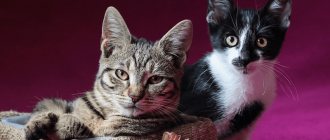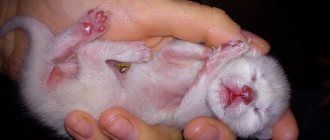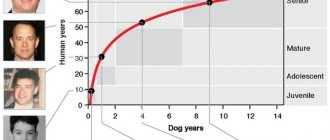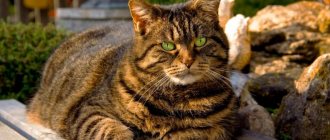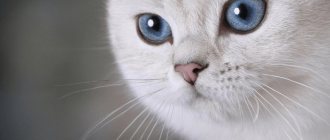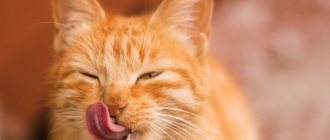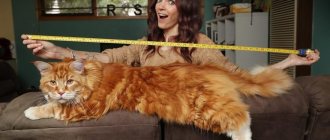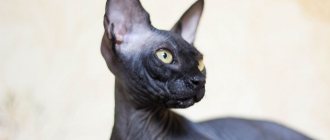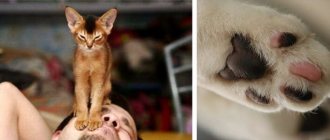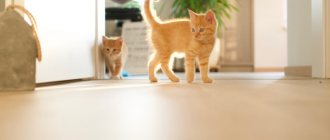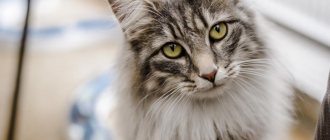It can be difficult for owners to determine the age of an animal, especially if it came into the family as an adult. Therefore, usually when cats turn gray, owners think that the animal is old or sick. However, veterinarians say that a change in color does not always indicate aging or disease.
The most telling sign of old age is poor dental health. It is by this criterion that veterinary specialists determine the approximate age of the pet. There are special tables that reflect changes in teeth over the years of life.
But can the appearance of gray hairs signal that the animal has entered old age? Or does a change in coat color indicate a problem with the body? These questions often concern responsible pet owners.
Gray hair in cats
Date of publication: 09.12.2019
It can be difficult for owners to determine the age of an animal, especially if it came into the family as an adult. Therefore, usually when cats turn gray, owners think that the animal is old or sick. However, veterinarians say that a change in color does not always indicate aging or illness.
The most telling sign of old age is poor dental health. It is by this criterion that veterinary specialists determine the approximate age of the pet. There are special tables that reflect changes in teeth over the years of life.
But can the appearance of gray hairs signal that the animal has entered old age? Or does a change in coat color indicate a problem with the body? These questions often concern responsible pet owners.
How cats go gray
It happens that colorless hairs appear even in kittens and young individuals. Sometimes whole areas of lighter fur appear on the fur. Suddenly, owners discover that their pet, which was previously monochromatic from the tips of its whiskers to the tip of its tail, now has, for example, a light-colored bib.
The animal may not have the usual silver hairs, which we usually consider gray, but brown or gray. The fur seems to fade, changing its color to a lighter and more faded color. This phenomenon is often mistaken for a sign of vitamin deficiency or dermatological problems.
Owners of older cats note that over the years, entire areas of faded fur have appeared on the animal. The fur especially changes color on the pet’s back, in the area of the muzzle and tail. It happens that by old age a pet completely changes color and becomes brown instead of black, for example.
When pets go gray
The fur can change color in a pet of any age. Sometimes this happens even in young children. But often animals actually turn gray from old age. After 7 years of age, cats develop light hairs on their back, face and ears. As a rule, this is accompanied by additional signs of aging.
In some cases, owners notice a change in the saturation of the color of the pet’s coat. Moreover, the change can affect both the entire coat and its individual sections. This phenomenon applies to both older animals and young individuals. Moreover, the color of the coat can change almost completely.
Another situation when a cat's fur turns gray is stress or illness. The reason for such changes can be a move, separation from the owner, or poor health of the pet. As a rule, in addition to the appearance of gray hair, in such situations the condition of the coat as a whole worsens.
Why does my cat have gray hair?
If gray hairs appear in a young animal, and the pet has no signs of illness, it is most likely a matter of genetics. Normally, a cat's fur color and pattern may change throughout its life. Most often, the color is formed by one and a half years, but there are cases when the color of the coat changes even later.
If gray hairs appear on an older animal, this can be considered a sign of aging. Like humans, cats experience a decrease in pigment content in their hair as they age. At the same time, it is important to take into account other criteria for the cat’s vitality: mobility, mood, condition of the skin and teeth.
Another reason for changes in fur color in a cat may be pathological processes in the animal’s body. As a rule, the situation is not limited to the appearance of gray hair and the animal experiences other alarming symptoms indicating illness. Sometimes the cause of the problem is a food allergy.
Causes of graying
A change in the color of a pet's fur can be affected by a stressful condition in it.
- Stress. Just like in people, early gray hair in cats is provoked by emotional experiences and stress (nervous shocks, moving, separation from the owner). Cats are sensitive to changes in environment and can take certain events “close to their hearts.”
- Pathologies. Difficult operations, anesthesia, and allergies also leave their mark on the animal’s fur—owners often find tufts of gray hair on a cat after long-term treatment.
- Age-related gray hair. Again, the threshold of old age is purely individual: some begin to turn gray by the age of 3-5, while others, coal-black, live to an old age, maintaining a rich coat color. On average, according to veterinarians' notes, the appearance of gray hair is normal at 8-12 years of age.
- Nutrition. Lack of macronutrients, amino acids and copper in food, which contribute to the production of melanin, is another cause of coat discoloration. If your pet's color has become faded and pale, it is worth adjusting its diet and consulting with a veterinarian about the selection of vitamin supplements.
Contrary to another popular belief, gray hair does not foretell the imminent death of a pet. The matter may be a genetic predisposition, and not a violation of mineral metabolism and the functioning of internal organs. Even if a cat turns gray early, while remaining cheerful and healthy in appearance, most likely this is a manifestation of the individual characteristics of the body, heredity or side effects of the breed.
Should I worry?
If your cat has gray hair or areas where the coat color has changed, do not panic. Observe your pet, paying special attention to the animal's appetite and activity level. If the cat eats and plays with pleasure, most likely, the appearance of gray hair is a natural process.
Changes in coat color often occur after the summer period, when the animal spent a lot of time outdoors during a country holiday. This symptom does not pose a big threat to the health of the animal, but in the future it is better to think about limiting walks during the hottest hours.
Alarm bells should be a cause for concern. If the animal has become lethargic, has lost its appetite and the cat prefers to sleep most of the day, this, without a doubt, requires the intervention of specialists. Worry should also be caused by deterioration in the quality of wool and the appearance of tangles.
Turning points
The owner of a cat with a serious illness needs to decide what moment is considered a turning point. Even animals with poor health, older cats, as a rule, have good days. Are you not ready to make a serious decision just because your pet sometimes becomes very ill? But prepare for the fact that the moment of need to make a decision may come in the future. If there are many more bad days than good ones, the animal will begin to suffer from severe pain that cannot be relieved by drugs, and the quality of its life will greatly deteriorate - this is the very moment.
It is painful to part with a pet, but attempts to prolong its life are not always appropriate. It is more important that the cat live a full life, and not exist. If the quality of life has greatly decreased, euthanasia becomes the only salvation for the doomed animal. If your cat is suffering greatly and medicine is powerless to help her, you have the right to decide to alleviate her suffering in the only available way.
What to do if your cat turns gray
If a cat's fur has turned gray and signs of a painful condition have appeared, owners should not postpone a visit to a specialist. With the Petstory app, you can get online advice from a certified veterinarian.
Without leaving your home, you will learn about the possible causes of gray hairs in an animal and, if necessary, draw up a plan for examining your cat with your doctor. Your veterinarian will help assess the severity of symptoms and inform you what tests and investigations you need to start treatment with.
If the cause of coat problems is an incorrect diet, using the Petstory app you can get advice on changing food, prescribing special supplements to improve the condition of the coat, and also learn about treating allergies.
Download the specialized application for pet owners Petstory on the IOS and Android platforms using the link – https://petstory.ru/prilozhenie-konsultacija-veterinar/.
Do cats go grey?
Many owners are not inclined to identify the cat’s physiology with their own, and, having discovered a couple of colorless hairs in their pet’s fur, they make a false conclusion: the cat is turning gray, which means he is sick. Worries are often in vain. Over time, the hair of many mammals - primates, dogs, people, and cats - loses pigmentation. Graying is just a side effect of age or heredity. It is not associated with skin changes and hair loss, the behavior and well-being of the animal, or a negative psychological environment. Therefore, if you notice silver hair in a cat’s skin, you should not panic: with proper care and nutrition, this is a typical process not related to health.
Do cats go grey?
The color of the coat changes over time and largely depends on heredity, especially if the black kitten has gray or smoky individuals in its family. Recoloration - a one- or two-three-fold change in color in youth - is often confused with premature gray hair. However, this is a typical process for black kittens. In youth, their color varies from brown to ashen and is finally formed by the age of one or one and a half years.
Changes in color throughout life and loss of fur pigment are a natural process for mammals, including cats. When a cat suddenly turns gray in combination with illness or if there is a suspicion of illness, the animal should be taken to the veterinarian.
In addition to overcoloring, veterinarians note a number of other reasons for variations in coat color - from heredity to nutrition. Thus, the color is affected by the change of seasons and temperature - the fur of some breeds (Siamese, Himalayan, Burmese cats) darkens in the cold season, and in the summer the black fur of those who like to lie in the sun fades into a chocolate or brown shade. Some genes responsible for the pattern may appear already in adulthood, affecting the uniformity of color. In this case, the hairs will be white, not gray.
Signs and superstitions
Gray cats in the eyes of people are almost the same mystical creatures as black ones. Gray is the color of fog, hiding from view what lies ahead, a symbol of an uncertain future and secrets. Ash-colored cats have their own signs and superstitions:
- A gray cat lures money into the house.
- Brownies love gray cats most of all. If you need to make friends with the spirit of your home, you should get just such a pet.
- Blue cats know how to ward off negative magical effects on the house or owners.
- If a gray cat has found its way to the house, you cannot drive it away. Most likely, he came to protect the family from an evil eye or damage.
- If the gray cat runs away, the owners will be in trouble.
- If in the morning, as soon as you wake up, the first thing you do is stroke a cat with ashy fur, the whole day will be successful.
- Cats with blue skin promote peace in the family and the establishment of good relationships between its members.
- Unlike black cats, they only cross the road for good luck.
Teddy Scotsman or airy Persian? Aristocratic Russian blue or stylish Egyptian? Terrible Maine Coon or sophisticated Oriental? There are many handsome gray dogs of different breeds and they are all so good that making a choice is not easy. And although this color is associated with despondency, boredom and dullness, the gray cat is a bright and spectacular animal.
Determining the age of the kitten
The most common reason for trying to estimate the age of pets is the decision to adopt a stray baby or adult cat.
If you need to determine the age of a kitten, it is enough to evaluate its development , and this is very simple. Suppose you found a squeaking lump, brought it home and are at a loss about what to do next... what to feed it, should it be warmed, how to care for it? The answers to all these questions depend on age, and it is determined by a number of characteristics.
Umbilical cord
Examine the kitten's abdomen, is the umbilical cord still in place? This means that you are dealing with a newborn baby who will not survive without proper care. On the first day the umbilical cord is wet, on the second day it dries out a little, and on the third (usually) it falls off.
At home, with proper complementary feeding, heating and care, a newborn kitten has a chance (not a guarantee) to survive. On the street, such a baby will die within 10–20 hours.
Eyes
At the first stage of development, two stages of the formation of a kitten’s eyes can be distinguished: the opening and acquisition of pigmentation. In newborn kittens, the eyes are closed, not glued together, but covered with a single flap of skin. The older the kitten, the more visible the furrow becomes, which will divide into the upper and lower eyelids.
Features and genetics of color
The coat looks gray with unevenly distributed black pigment. If you look at a hair under a microscope, you can see that there are white spaces between the black areas. The amount of carbon pigment in the bulb itself does not affect the color: gray cats have the same amount of it as black cats. An ashy shade is obtained when eumelanin fills only part of the pigment cells of the hair, and some remain uncolored. In this case, filled and empty cells alternate not one at a time, but in small clusters. The ratio of the sizes of the white and black zones on the hair determines how light the shade will be.
Gray cats are carriers of the dominant black gene. Genetically, their difference from black cats is not associated with the white gene - this gene is the strongest of all, and if it is dominant, regardless of the set, a white kitten is born. The difference in color is due to the color density gene. Being dominant, it determines uniform staining of cells and vice versa. That is, in gray cats, unlike black cats, it is recessive.
If the genes for black color and density turn out to be recessive, and there is no dominant red gene responsible for the orange pigment (pheomelanin), the gray coat color will have a warm tone. This color, if solid, is called lilac.
The undercoat of gray wool can be light, even white. This gray-white cat has a smoky coloration.
Determining the age of an adult cat
Finding out the age of a cat if you decide to get an older pet is a little more difficult. You can tell the exact age of a cat only if you know when it was born; in other cases, there is a possibility of a significant error. However, there is no need to worry, since it is quite possible to distinguish a young cat from an adult and an elderly one.
Tough
The easiest way to assess age is to examine the dentition. Let us immediately make a reservation that the following indicators are very approximate , since they depend on the quality of care, accommodation and metabolic rate of the animal.
- Age 1–2 years: teeth look “like new”, that is, white, healthy, strong, with a bluish tint, not worn out.
- Age 2–2.5 years: the first wear of the incisors appears.
- Age 2.5–3 years: yellowness and a small amount of tartar appear. If your teeth have been taken care of, this sign is not relevant.
- Age 3–3.5 years: wear on the incisors is clearly visible.
- Age 5 years: the first wear of the fangs appears.
- Ages 5–7 years: obvious wear on the lower incisors.
- Ages 8–10 years: obvious wear of the upper incisors.
- Age over 10 years: gradual loss of lower incisors.
- Age over 11 years: gradual loss of upper incisors.
- Age 14–15 years: incisors are completely or partially absent, gradual loss of canines.
Determining the age of a cat by the presence or absence of tartar is not very logical, since the formation of growths depends on the type of food. If you adopt a cat from the street, a clearer indicator is tooth wear , as stray animals brush their teeth on branches and grass, often eat hard food, or may lose a tooth due to disease.
Estimating age by teeth has a very large error if the cat has chronic gum problems.
According to other signs
The approximate age of a cat can also be determined intuitively by assessing it by external signs. The nuance is that a well-groomed animal will look young even at 5 years old, but a street cat may seem much older, although it is not yet 3 years old. There is an opinion that gray hair is a sign of old age, but this is not true.
The only case in which this statement is true is if you are determining age by looking at a cat's whiskers . The older the animal, the more developed its whiskers. Cats older than 9–10 years have hard, long, but colorless (gray) whiskers. However, this indicator is very conditional, since the length, thickness and presence of a mustache are hereditary factors.
Cats with thick, bushy and very long whiskers are considered to have or are likely to have vision problems.
Determining age by the color and condition of the coat is not relevant if you do not know in what conditions the cat lived, but even here several nuances can be highlighted:
- White fur on the chin is not necessarily gray hair.
- Gray hair is colorless or has a silver tint.
- It is almost impossible to determine gray hair in a light-colored cat.
- Black cats practically do not turn grey, but change color to brown.
- In older cats, the fur around the eyes becomes less dense.
Another indicator of age is the eyes, more precisely, the condition of the iris . The older the cat, the lighter the eye color. Again, some cats have irises that are genetically light in color (blue, hazel, pearl, light moss). In outdoor cats, their eyes fade much faster. In animals that lived indoors and did not go outside, bright eye pigmentation lasts longer.
Aging
Generally, a graying muzzle is a sign that a dog is getting older.
Typically, a dog reaches old age between seven and ten years of age, but depending on its size, it may begin to age even earlier. For example, according to the American Veterinary Animal Association (AVMA), very large breed animals (those that weigh 41 kg or more) can be considered seniors by age five. Small and medium breeds (up to 23 kg) can be considered senior at around seven years of age. Genes also play a role in the appearance of gray hair in a dog, as some breeds have a genetic predisposition to this. It's also worth noting that gray hair is more visible on a dark-colored face than, say, on a West Highland White Terrier. Dogs who have reached old age may benefit from switching to a senior dog food. While it won't eliminate the cause of your pet's gray hair, the best dog foods for senior dogs are formulated to help mitigate the effects of aging. For example, Hill's Science Plan Youthful Vitality was formulated to take into account the changing bodies of pets aged seven years and older. Science Plan contains advanced nutrients that are formulated using Hill's proprietary formula of natural ingredients including fruits, vegetables, fatty acids and antioxidants, plus added vitamins, minerals and amino acids - all designed to combat the signs of aging. Their formula is designed to help support normal brain function, energy and vitality, as well as a healthy pet's immune and digestive systems. They also contain essential fatty acids, which make animals' fur shinier and softer.
Graying - for any reason - can change your dog's appearance. But she will still be happy and healthy thanks to the same love and attention that she always needed!

